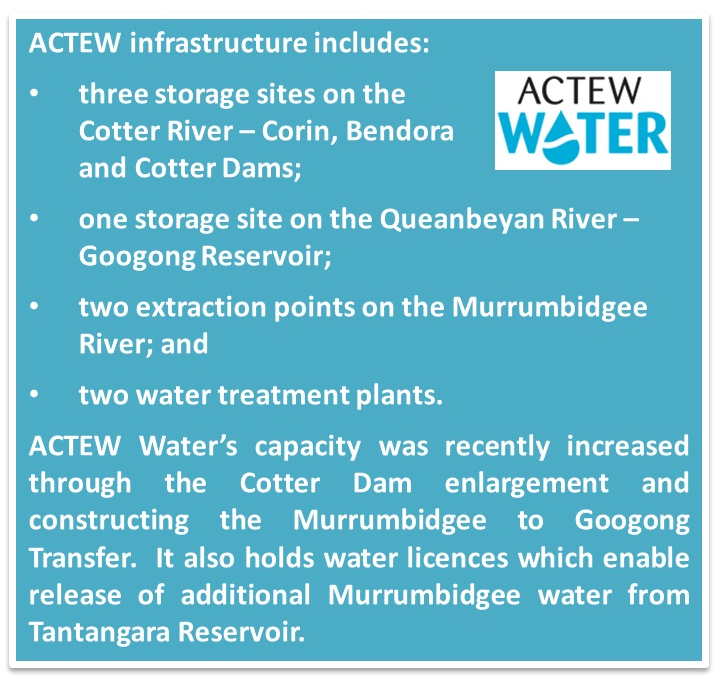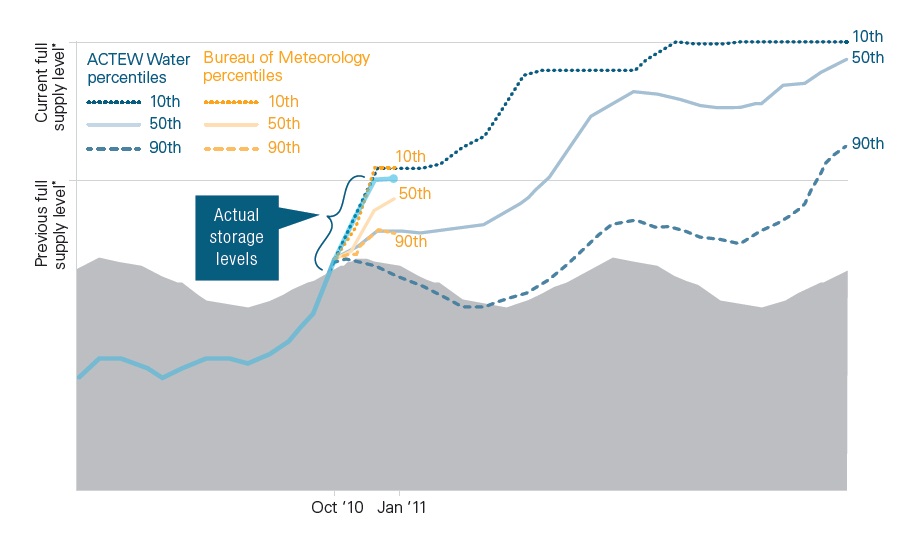Seasonal Streamflow Forecast Service influencing water decisions
Contributed by Paul Feikema
 Australian streamflows are among the most variable in the world. Streamflow forecasts are vital in helping water managers and users make informed decisions. They indicate the likelihood of being above or below defined criteria for making certain decisions and can help water managers make decisions such as choosing a water source or whether environmental flows should be allocated.
Australian streamflows are among the most variable in the world. Streamflow forecasts are vital in helping water managers and users make informed decisions. They indicate the likelihood of being above or below defined criteria for making certain decisions and can help water managers make decisions such as choosing a water source or whether environmental flows should be allocated.
In 2010, using the seasonal streamflow forecasts issued by the Bureau of Meteorology, ACTEW, a government-owned utility that provides water services to an urban population of around 415  000 people in ACT (Australian Capital Territory) and the Queanbeyan Council area, was able to confidently remove temporary water restrictions after the 1997-2009 millennium drought.
000 people in ACT (Australian Capital Territory) and the Queanbeyan Council area, was able to confidently remove temporary water restrictions after the 1997-2009 millennium drought.
The Bureau’s Seasonal Streamflow Forecast Service reduced the range of likely outcomes and the decision to remove water restrictions had a lower risk than the projections based on historic climate indicated.
The case of the 1997-2009 millennium drought restrictions
The 1997–2009 millennium drought placed severe stress on water security in the Australia Capital Territory. In response, ACTEW Water put a range of water security measures in place. Temporary water restrictions were in effect between 2003 and 2010, with more severe restrictions active from 2006 to 2010.
In spring 2010, ACTEW Water was considering whether water storage levels had increased enough to remove restrictions before summer. To determine if temporary water restrictions are necessary, ACTEW Water considers many factors, such as:
- current conditions such as weather, water storage levels, consumption and inflows;
- historic consumption and inflow;
- available forecasts and projections; and
- how frequently changing restriction levels affect communities and businesses.
ACTEW Water uses indicative water storage levels for introducing stages of temporary water restrictions and for keeping restrictions in place. Due to the large variability in historic climate data, a small number of scenarios showed that water in the storages would remain below the level needed to lift restrictions over summer.
To assist, the Bureau provided ACTEW Water with seasonal streamflow forecasts.
ACTEW Water converted these into water storage forecasts and overlaid them onto the historic reference period. The streamflow forecasts were much less variable than historical data, and they are accurate and reliable. Importantly, the Bureau’s streamflow forecasts did not indicate that water storages would decline below the level needed to keep restrictions in place. In fact, the forecasts showed there was a high chance that storage levels would increase.
This provided ACTEW Water with the confidence to remove water restrictions in October 2010. The decision proved prudent as the storage levels increased and remained above the threshold for water restrictions.
Comparison of the Bureau’s seasonal streamflow forecast and ACTEW Water storage projections
How does ACTEW Water use the Bureau’s streamflow forecasts?
ACTEW Water applies the Bureau’s forecast using the following process:
- Three-month 10th, 50th and 90th percentile forecasts are selected for: Gingera, upstream of Corin Dam; Tinderry, upstream of Googong Dam; and Tennent on the Gudgenby River.
- Forecasts are converted to monthly inflows using disaggregation factors specific to each month and location.
- These flows are incorporated into ACTEW Water’s water supply planning model, along with estimates of water demand.
- Operational and environmental rules are applied to projected storage levels from each of the forecasts.
- Data are overlaid onto two-year water storage projections developed from their historic reference climate via the same water supply model.
- Projections then inform ACTEW Water’s strategic operational decisions.
The 2010 case study showed clearly how ensemble seasonal streamflow forecasts enable better water management, with positive impacts on community and businesses.
Co-authors: Katherine Larkings (ACTEW), Trudy Wilson (BoM), Timothy Purves (ACTEW), Paul Feikema (BoM)
Document for download: ACTEW Water Case-Study
Find out more:
Bureau of Meteorology : www.bom.gov.au/water/ssf
ACTEW Water: www.actew.com.au

0 comments